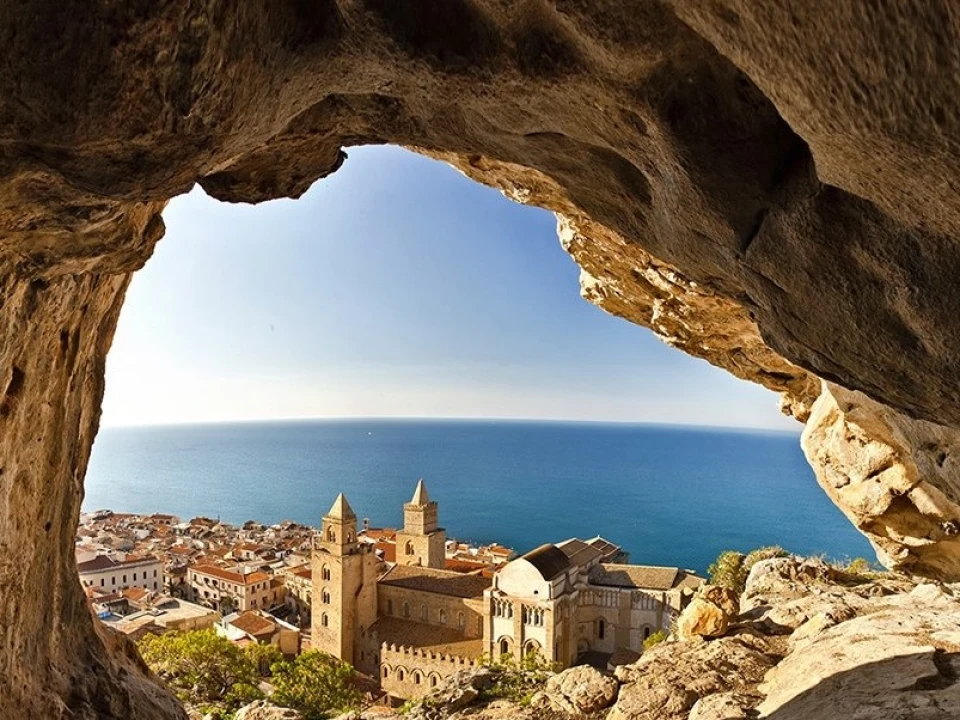The cathedral is still the hub around which the entire old town of Cefalù revolves, placed in a fascinating setting between the vast horizon of the sea and the broad mountain rising above it. The Rock towering over the city, called the "promontory of Hercules" by the Phoenicians, is a limestone hill 270 m high, from the summit of which there is a splendid view. At the top there is a megalithic structure known as the Temple of Diana, possibly connected with a water divinity, as would be demonstrated by the nearby cistern from the 9th century BC.
From the same period (late 5th cent. BC) as the temple, which fascinated European travelers, is the megalithic circuit of defense walls, of which vestiges remain intact along the cliffs of the Giudecca (Postierla) and near the ancient Porta Terra (today Piazza Garibaldi). But let us return to the Cathedral.
It is a mystery why Roger II wished to build such an imposing church, destined to become also his mausoleum, in this small town instead of in Palermo, the capital of his kingdom. The fact remains that the Norman king built his masterpiece here: it is so huge that it almost escapes one´s field of vision, austere in the compact block of its two towers, but made precious by the warm golden color of its walls and the dazzling mosaics inside.
What is bizarre is that this Norman temple, bound by Byzantine liturgical prescriptions, was designed and built by Islamic architects and workers, still present in Sicily within the sphere of the cultural ties linking the island to the Maghreb region. In short, a wonderful synthesis of three cultures, stimulated by the fact that the king desired a church that would also be a fortress and a funeral monument. Thus at the foundation of the project was the Maghrebian architecture of the Zirite and Hammadite fortress-palaces, the same culture that allowed Roger to build masterpieces in Palermo.
Inside, the cathedral is dominated by the solemn rhythm of the colonnade and the huge image of Christ Pantocrator (here said to be more beautiful than the one in Monreale) in the apse, entirely in mosaic with a gold background, with inscriptions in Greek and Latin, exquisitely made by Byzantine artists (1148).
The wooden cross hanging in the central apse is attributed to Guglielmo da Pesaro (15th cent.). Also worthy of note are the Romanesque baptismal font and the cloister next to the cathedral, decorated with coupled columns topped by carved capitals.
Leaving behind this imperial fragrance, this fire of old icons, we can continue with our discovery of the other treasures of medieval Cefalù.
Examples include the Palazzo Maria on Piazza Duomo and the Osterio Magno on Corso Ruggero. The latter building, which dates from the 13th century, was probably built over a pre-existing structure, identified, according to a false tradition, as the residence of King Roger. Owned by the Ventimiglia counts, it has two beautiful two-light mullioned windows and a three-light window from the 13th and 14th centuries, respectively. Today it is used as an exhibition space.
Not to be missed is the medieval washhouse, which is entered by means of an elegant staircase in lava stone. Carved entirely out of the rock and used until fairly recently, it is at the mouth of the Cefalino river - mentioned by Boccaccio - which originates in the mountains at an elevation of 1000 meters and reaches Cefalù after flowing underground for 12 km.
The Baroque, another golden age in Sicily, can be seen in Cefalù in the façades of the Monte della Pietà (1716) and the beautiful Church of Purgatorio (1668), as well as in portals, corbels and other architectural details that enliven hidden corners, streets and small squares in the historic center, the layout of which nonetheless remains medieval. In the Church of Purgatorio there is a rectangular crypt with completely desiccated corpses.
Also of interest are the Bishop´s Seminary (1638) on Piazza Duomo and the Mannerist rusticated portal of the 16th-century Palazzo Piraino.
A tour of Cefalù is not complete without a visit to the Mandralisca Museum, even if only to see - amid the many collections - the extraordinary Portrait of an Unknown Man (1465-70) by Antonello da Messina.
Having seen all the masterpieces, it is pleasant to simply wander aimlessly through the narrow medieval streets, characterized by the small arches connecting one building to the next.
At the end of the tour, passing through Porta Pescara one comes to the marina. The old port is a mesmerizing sight, especially in the evening.
The name
Kephaloidion is a Greek name that means "head," in the sense of "cape," or "extremity" or "point," in which case it stands for the promontory, the rock.
The Romans called it Coephaledium, whereas for the Arabs it was Gafludi, a fortified town with abundant water.
The product
The olive-tree-covered hill plunges into the sea, vineyards and orchards thrive in the fertile contrade, and the promontory overlooks the beach, rocks and small gulfs along a coast lined with centuries-old pines.
The "product" of Cefalù is to be sought in this enchanting scene. Attention should be paid also to the daily ritual of offshore fishing.
The most common types of fish are "a sciabica" (small sardines) and "a tre maglie" (blue-fish).
The recipe
Cefalù is permeated with the air of the sea, and many of its traditional dishes feature seafood.
But the queen of Cefaludese cuisine is based on meat: pasta ´a taianu is a delectable and poetic miscellany of flavors and aromas, and is the main dish for the Festival of the Holy Saviour.
This pasta is made with a ragù sauce with meat and fried eggplant.




